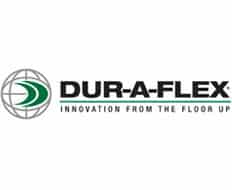

Dur-A-Flex cementitious urethane floors are seamless, monolithic floors, easy to maintain and keep clean—no cracks or grout lines for dirt and grease to hide in, no tile that might break under a dropped stockpot.
“This floor is easier to clean and sanitize than quarry tile, where grout lines crack and water stagnates and harbors bacteria,” says Alex Dittenhoffer, strategic accounts manager. “The food industry is migrating towards seamless floors.”
But not all seamless flooring is created equal in the food world. “Epoxy floors, for example, are not the right choice for a food environment,” says Dittenhoffer. “Epoxy cannot handle lactic acid, which is just part of the life in a kitchen and food environment. That acid destroys epoxy flooring. Our cementitious urethane floors tolerate lactic acid all day long.”
The urethane floors hold up to heat better than epoxy flooring. “If you spill hot oil or hot water on a urethane floor, the flooring expands and contracts at the same rate as the subfloor (typically concrete). Because of that, it will not delaminate from the subfloor. Epoxy expands and contracts on its own, and before long an epoxy floor delaminates,” says Dittenhoffer.
“We can also control the surface texture as we install the floors. Where people work, the floors can be slip-resistant, which prevents slip-and-fall accidents, keeping staff safe and reducing liability,” he adds. The floors have some give in them, as well, making them easier to stand on than tile and eliminating the need for the big rubber mats used over tile.
“You can install this floor anywhere in the country and get consistent results, important to brands building a consistent image across the country.”
In some applications, the fact that Dur-A-Flex floors can be sealed to make them waterproof has actually helped a restaurant get permitting for certain sites. “That is a big benefit if the restaurant is on the second floor of a commercial building, such as a site in the food court of a shopping mall. Restrictions on building in those spaces are tight, and a fully waterproof floor can make it easier for a restaurant to be accepted,” Dittenhoffer explains.
As Dur-A-Flex grew over the course of 40 years, the company developed relationships with installers nationwide. “We use highly-trained contractor installers, so you can install this floor anywhere in the country and get consistent results, important to brands building a consistent image across the country,” says Dittenhoffer.
Installation is easiest with new construction, but Dur-A-Flex does plenty of renovation work, especially as restaurant kitchens leave quarry tile behind. “We schedule installation around the quietest days of business,” says Dittenhoffer. “In fact we recently installed urethane floors system-wide for one quick-serve chain, and they didn’t even have to close for a single day.”
One reason installation can take place while business continues is that the floors have zero to very low VOCs. They are made, in many cases, from rapidly renewable resources, and all of the Dur-A-Flex flooring products contribute towards LEED points in a building.
The floors aren’t just for the kitchens. “We have a number of restaurants where we’ve done front-of-house applications. We have a wide range of colors and patterns, metallic looks, even a number of stained looks, which simulate the popular look of stained concrete, but with a better product. We can add a logo to a floor or color different sections to identify different areas of the restaurant,” says Dittenhoffer.
“If you install a cementitious urethane floor, you can expect to replace it…well, about when it is time to replace the building. They really last that long.” And with cost competitive with other floors on the market, investing in a lifetime cementitious urethane floor simply makes sense.
For more information about franchising opportunities with Dur-A-Flex, visit dur-a-flex.com
